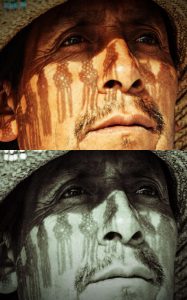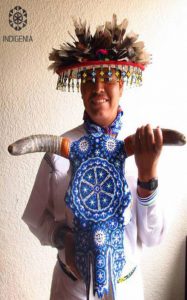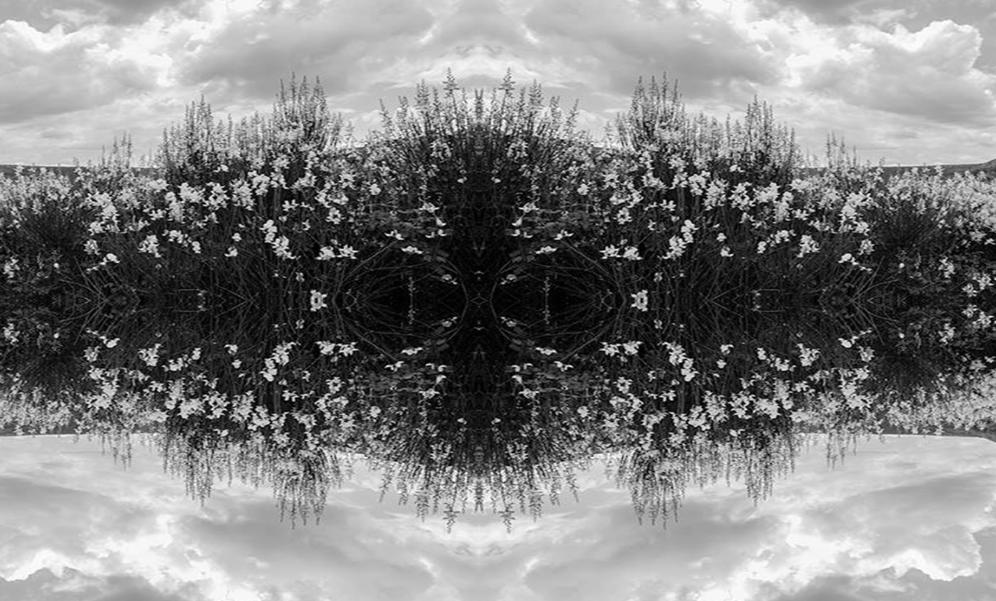All Latin American, whether we want to acknowledge it or not, come from different cultures. We re a mixture of cultures, of knowledge, nationalities, we are mixed- raced. And, we are mixed – raced because when the colonization took place and after it, Europeans meshed with natives. How ever, there are native cultures that resisted change, that did not allow the influence of capitalism, by the need to consume more and more, by wars, by the prostitution of the soul.
México
Mexico wasn’t the exception to this cultural and world blend. It is the the fifth largest country in the Americas, the fourteenth largest country in the world, the eleventh most populous with 118 million people, Spanish is their official language and recognize 67 indigenous languages.

One of this native cultures is the Wixárika. They have resisted, they have kept all ties to their traditions. They are indigenous people of Mexico, living in the in the central western part of the country, mainly in the states of Jalisco, Nayarit and parts of Durango and Zacatecas. Furthermore, each of its communities is autonomous, they have their own civil and religious authorities.
For the Wixárika, the civilian authority is governed by totohuani and it is renewed on a yearly basis. Additionally, the maraakates o maraakanes, priests, are responsible for keeping and maintaining their traditions.
They, have kept their central activity which is based upon their religious tradition. It centers in the gathering and consumption of the híkuri. They maintain an oral history, passed on from generation to generation.
Capitalist ambitions
Until here, everything seems ok. But, as expected so much harmony and beauty could not last forever. Capitalist ambition has decided that they want to take away their territory, make them go away, take away what belongs to them since centuries ago just to fill their pockets with money.
In order to sell this lands they have to get rid of the people. “That is what the mexican government is doing: they displace people, kill and incarcerate them, deny them basic health care. In two years, this government has put 8 million indigenous people behind bars”, Beatriz Paz, the co founder of Indigenia, explained outraged. At the moment there are 56 indigenous groups; between them, the mixed – raced and migrants, well this makes Mexico a world cultural power.
“It has 80% of the cactus diversity of the world, silver, amber and the híkuri, peyote, that although it grows in some parts of North America, is let’s say, endemic of this region.”
To be exact, eight years ago, a group of Canadian mining companies that have subsidiaries in Mexico have wanted and realized more than eleven thousand tests to buy this lands. And, this is extremely delicate because they only live in four states of the country.
Rituals
Every two months they have sacred rituals and once a year they make a pilgrimage to the dessert to eat híkuri, peyote, everyone in the community goes.
When they make the pilgrimage they do it from all four states and go to a fifth state where the Wirikuta desert is located, it is a federal reserve, it is protected by the UNESCO and it is recognized as a sacred natural and human heritage site .
So, seeing all that was happening and really worried because of this problem, a group of close and social invested friends created INDIGENIA in 2012. It is a is a trans disciplinary agency that develops models, tools and spaces for cultural interaction between indigenous and global societies. The fist campaign they developed was “Wixárika Mundus. The flight of the blue deer” and the idea is to take water to the Wixárika community in San José del Bajío en Jalisco.

People who live in San José del Bajío are craftsman that wish to extend their cultural heritage and knowledge as well as having drinkable water. “With INDIGENIA I have dedicated myself to generate and share material, imparted some Zin production workshops and talks in cultural and educational centers”, Paz tells me proudly.
“ They speak to the fire, to the volcanoes in the middle of the country, with the littoral region, with the northern part of the desert. This means that they have a very strong connection to the land.”
The Wixárika culture, is one of the most secretive and airtight cultures in Mexico, since the Spanish conquest they have maintained isolated in their lands and have not permitted colonization in any form… “almost a decade ago, a reporter from the USA went in and started taking pictures without any permission, they didn’t take the camera, or the watch or anything but they killed him because he took pictures without permission and they are a very airtight community”.
The consequences
This mining companies want to buy this land and that means that this ancestral community will no longer have access to the place they have used for pilgrimage during the last thousand years. Where they contacted their forefathers, with future generations and all nature elements.
Given what was taking place, they began coming out. They began asking for help and began talking to others about their culture.

They got divided into three groups: “one of them said: if we want to survive we have to tell others about us so that they can help us even if this means losing a bit of our identity; others said: ok, we’ll do it but just a bit; and the third group said: we would rather die before leaving our territory and selling out.”
The group of indigenous people that work with the organization are from the second group, they want to show the world about their culture but they do not want to loose their identity in the process.
“For us, it is very important to maintain and preserve this culture not only because they are a part of who we are as a country but because we consider the híkuri as a part of the world heritage.”

This is a very important thing because they have been such a culturally airtight community and since all of this problems began many have found a way out in the programs that we have.
For them the híkuri represents three things, anthropologists have been able to see the connection of evolution with it… a deer and that represents the hunting society; a corn that represents the agricultural society.
A cactus that gets you high and represents the gathering community, but it is the three of them and in the analysis of their rituals it is noted that they consider the híkuri those three things.
It has to be noted that not everyone in the community knows has to cut them, they are the “peyoteros” and this is important because this is a slow growing cactus that only grows in the desert… and if they cut it wrong it won’t grow back.
The daughter of one of our partners in the foundation, died from dysentery.
In 2013, 8 people died in this community, it is a lot given that there are only three families and there are no more than 45 people.
This is extremely dangerous when we say they are an ancestral culture, thousand-year-old and that their only survival method is through people and if eight die, that means a lot of future generations. The Indigenia team came together because of the necessity of the water and because they enjoyed working side by side with the indigenous community.
If this mining companies reach their objective, an entire civilization would come to an end as well as the sustainability of the region.
“The híkuri, is at the center of this culture and everything revolves around it… meaning that this culture in unthinkable without the híkuri.”
This region is deserted and to achieve desoxidation and everything they have to place under the land, they would go through the phreatic zone and the water of all the region would be polluted.
“This is why we chose to help them. They are in extreme need due to the pressure form the mining industries”.
Collaboration with other artist is essential in order to achieve the goal of the foundation.

Someone that works with an artistic discipline is identified, they have to be good, they must have certain level.
Afterwards they receive an information package with images from this culture in order to absorb and identify with them. “They give us the art piece, we sell it and the profit goes to the community. First and foremost, to the investigation of water, how to obtain it and have better access to it”.
Indigenia
The first campaign, that Indigenia did is for the water. Local artist would showcase their art pieces, inspired on this culture as well as original Wixárika art. All of the profits will go to the creation of a water recollection network.

The first campaign, had the aim of promoting the art of Tutú Témai (Juan de la Cruz Bautista), member of the Wixárika community in San José del Bajío. Tutu’s community is experiencing very serious problems because of the pressures from capitalist groups. This groups want to take their land away from them, extreme poverty and the drought.
The Wixárika are fighting to defend their community and their land, once more the government wants to impose a big scale project. Obviously, they will be affected, nobody has cared or taken in consideration how this will affect the members of those indigenous people. They, as indigenous communities, have a different concept of Mother Earth. For them, rivers are veins and animals are brothers. The only thing that they want is to defend their culture and life. What they want as an organization is to help this community, defend their heritage, make their voices heard.


